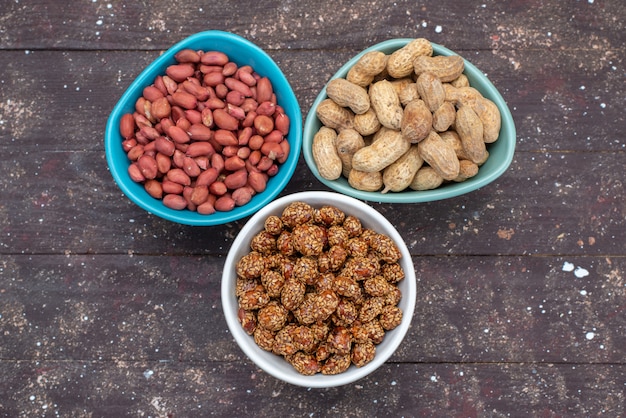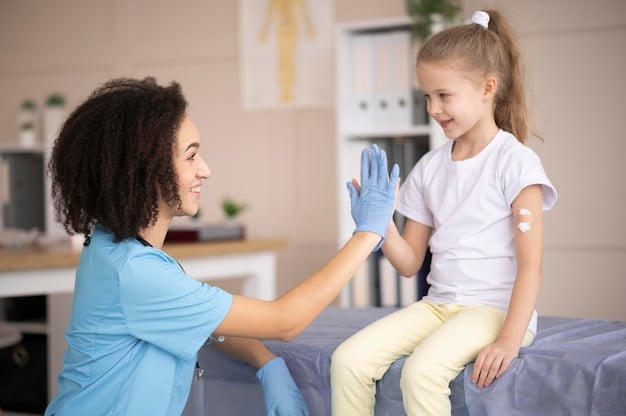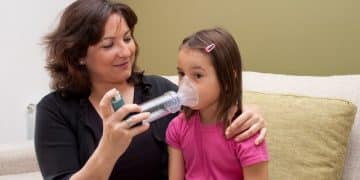Managing Childhood Allergies: Latest US Treatment Options

Managing allergies in children involves identifying triggers, implementing avoidance strategies, and utilizing various treatment options available in the US, including medications, immunotherapy, and emerging therapies to improve their quality of life.
Discover the latest approaches to managing allergies in children within the US, offering insights into innovative treatment options that can significantly improve your child’s health and well-being.
Understanding Allergies in Children: A Comprehensive Guide
Allergies in children are a common concern for parents in the US. Understanding what allergies are, how they develop, and the common triggers is essential for effective management. This section provides a foundational overview of pediatric allergies.
What Are Allergies?
Allergies are immune system responses to substances that are typically harmless, known as allergens. In children, the immune system mistakenly identifies an allergen as a threat and produces antibodies called immunoglobulin E (IgE). When the child is exposed to the allergen again, these IgE antibodies trigger the release of chemicals, such as histamine, leading to allergic symptoms.
Common Allergy Triggers in Children
Identifying the specific allergens that affect your child is crucial for effective management. Common triggers include food allergens like peanuts, tree nuts, milk, eggs, soy, wheat, and shellfish. Environmental allergens such as pollen, pet dander, dust mites, and mold can also cause allergic reactions. Insect stings and certain medications are less common but can also trigger allergies.

Here are some of the most prevalent allergy triggers that affect children:
- Food Allergens: Peanuts, tree nuts, milk, eggs, soy, wheat, and shellfish are among the most common food allergens in children.
- Environmental Allergens: Pollen, pet dander, dust mites, and mold can trigger allergic reactions year-round or seasonally.
- Insect Stings: Stings from bees, wasps, and other insects can cause severe allergic reactions in some children.
- Medications: Certain medications, such as penicillin, can trigger allergic reactions in sensitive individuals.
Recognizing these triggers and understanding how they affect your child can help you take proactive steps to minimize exposure and manage allergic reactions effectively. Proper diagnosis and testing by an allergist are essential in identifying specific allergens and developing a personalized management plan.
In summary, understanding the underlying mechanisms of allergies and identifying common triggers is the first step in effectively managing allergies in children. This knowledge empowers parents and caregivers to take proactive measures to protect their children and improve their quality of life.
Diagnosing Allergies in Children: Tests and Procedures
Accurate diagnosis is the cornerstone of effective allergy management in children. This section outlines the various tests and procedures used by allergists to identify specific allergens and assess the severity of allergic reactions.
Skin Prick Testing
Skin prick testing is a common and reliable method for identifying allergens. It involves placing small amounts of suspected allergens on the skin and pricking the surface to allow the allergen to enter. A raised, red, itchy bump (wheal) indicates a positive reaction, suggesting an allergy to that substance. The test is typically performed on the forearm or back and is relatively quick and painless.
Blood Tests (IgE Antibody Tests)
Blood tests, also known as IgE antibody tests or RAST tests, measure the amount of IgE antibodies in the blood in response to specific allergens. These tests are particularly useful when skin testing is not feasible, such as in children with severe eczema or those taking certain medications. Blood tests can identify a wide range of allergens, including food, environmental, and insect venom.
Elimination Diets
Elimination diets are often used to diagnose food allergies. This involves removing suspected food allergens from the child’s diet for a period of time (usually 2-4 weeks) and monitoring for symptom improvement. Once symptoms subside, the suspected foods are reintroduced one at a time to determine which ones trigger allergic reactions. This process should be conducted under the guidance of a healthcare professional or registered dietitian.
Key aspects of allergy diagnosis include:
- Detailed Medical History: A thorough review of the child’s medical history, including symptoms, triggers, and family history of allergies.
- Physical Examination: A physical examination to assess the child’s overall health and look for signs of allergic reactions.
- Allergy Testing: Skin prick tests and blood tests to identify specific allergens.
Early and accurate diagnosis is essential for developing an effective allergy management plan. Working closely with an allergist can ensure your child receives the appropriate testing and personalized recommendations to improve their health and well-being.
Medication Options for Managing Allergies in Children
Medications play a crucial role in managing allergy symptoms and improving the quality of life for children with allergies. This section explores the different types of medications available and their common uses.
Antihistamines
Antihistamines are commonly used to relieve allergy symptoms such as itching, sneezing, runny nose, and hives. They work by blocking the effects of histamine, a chemical released during an allergic reaction. There are two main types of antihistamines: first-generation and second-generation. Second-generation antihistamines are generally preferred because they are less likely to cause drowsiness.
Corticosteroids
Corticosteroids are anti-inflammatory medications that can reduce swelling, redness, and itching associated with allergic reactions. They are available in various forms, including nasal sprays, creams, and oral medications. Nasal corticosteroids are often used to treat allergic rhinitis, while topical corticosteroids are used to treat eczema and other skin allergies. Oral corticosteroids are typically reserved for severe allergic reactions due to their potential side effects.
Effective medication strategies include:
- Regular Use: Taking medications as prescribed, even when symptoms are mild, to prevent allergic reactions.
- Combination Therapy: Using multiple medications, such as antihistamines and nasal corticosteroids, to manage different allergy symptoms.
- Emergency Medications: Keeping epinephrine auto-injectors (EpiPens) readily available for children with severe allergies to treat anaphylaxis.
Decongestants
Decongestants help to relieve nasal congestion by narrowing blood vessels in the nose. They are available in oral and nasal spray forms. However, decongestant nasal sprays should be used with caution as prolonged use can lead to rebound congestion. Oral decongestants may cause side effects such as increased blood pressure and restlessness.
In conclusion, medications can effectively manage allergy symptoms in children when used appropriately. Working with a healthcare provider to develop a personalized medication plan is essential for achieving optimal symptom control and minimizing potential side effects.
Immunotherapy for Children: Building Tolerance to Allergens
Immunotherapy, also known as allergy shots or allergy tablets, is a long-term treatment that can reduce sensitivity to allergens. This section explores the benefits, procedures, and considerations of immunotherapy for children.

Allergy Shots (Subcutaneous Immunotherapy)
Allergy shots involve injecting small amounts of allergens under the skin over a period of time. The goal is to gradually build tolerance to the allergens and reduce the severity of allergic reactions. Allergy shots are typically administered weekly during the buildup phase, followed by monthly maintenance injections. This treatment is effective for allergies to pollen, dust mites, pet dander, and insect venom.
Allergy Tablets (Sublingual Immunotherapy)
Allergy tablets, also known as sublingual immunotherapy (SLIT), involve placing a tablet containing allergens under the tongue until it dissolves. This method is convenient and can be administered at home. Currently, allergy tablets are available for allergies to grass pollen, ragweed pollen, and dust mites. SLIT is generally well-tolerated and has been shown to reduce allergy symptoms.
Key advantages of immunotherapy include:
- Long-Term Relief: Immunotherapy can provide long-term relief from allergy symptoms, even after treatment is discontinued.
- Reduced Medication Use: Immunotherapy can reduce the need for allergy medications, such as antihistamines and corticosteroids.
- Prevention of New Allergies: Some studies suggest that immunotherapy may prevent the development of new allergies.
Benefits of Immunotherapy
Immunotherapy can be a life-changing treatment for children with allergies. It can reduce reliance on medications, improve quality of life, and potentially prevent the development of new allergies. However, it’s important to consult with an allergist to determine if immunotherapy is the right option for your child and to understand the potential risks and benefits.
In brief, immunotherapy for children can be a highly effective treatment for reducing sensitivity to allergens. Allergy shots and allergy tablets are two common methods that can provide long-term relief and improve quality of life.
New and Emerging Allergy Treatments for Children
The field of allergy treatment is constantly evolving, with new and emerging therapies offering hope for better management of allergies in children. This section explores some of the latest advancements in allergy treatment.
Biologic Medications
Biologic medications are designed to target specific components of the immune system that contribute to allergic reactions. For example, omalizumab is a biologic medication that blocks IgE antibodies and is used to treat severe allergic asthma and chronic hives. Other biologic medications are being developed to target different aspects of the allergic response.
Epicutaneous Immunotherapy (EPIT)
Epicutaneous immunotherapy involves applying a patch containing allergens to the skin. The patch delivers the allergens through the skin, gradually building tolerance. EPIT is currently being investigated for the treatment of peanut allergies and other food allergies. Early studies have shown promising results in reducing allergic reactions to peanut exposure.
Emerging trends in allergy treatment include:
- Personalized Medicine: Tailoring allergy treatment to the individual based on their specific allergens, symptoms, and immune response.
- Precision Diagnostics: Developing more accurate and sensitive allergy tests to identify specific allergens and assess the severity of allergic reactions.
- Combination Therapies: Combining different treatment approaches, such as medications, immunotherapy, and lifestyle modifications, for optimal allergy management.
Oral Mucosal Immunotherapy (OMIT)
Oral mucosal immunotherapy involves applying a small amount of allergen to the oral mucosa (lining of the mouth). This method is being investigated for the treatment of food allergies. OMIT aims to desensitize the child to the allergen by gradually increasing the dose over time.
Overall, ongoing research and development are leading to new and improved allergy treatments for children. These advancements offer the potential for more effective symptom control, reduced reliance on medications, and improved quality of life.
Lifestyle Adjustments and Home Remedies for Allergy Management
In addition to medical treatments, lifestyle adjustments and home remedies play a crucial role in managing allergies in children. This section outlines practical steps that parents can take to minimize allergen exposure and alleviate allergy symptoms.
Creating an Allergy-Friendly Home Environment
Reducing allergen exposure in the home can significantly reduce allergy symptoms. This includes regular cleaning to remove dust mites, pollen, and pet dander. Using allergen-proof bedding, such as mattress and pillow covers, can also help minimize exposure to dust mites. Air purifiers with HEPA filters can remove airborne allergens from the air.
Dietary Modifications
For children with food allergies, strict avoidance of the offending foods is essential. Parents should carefully read food labels and educate their children about the importance of avoiding allergenic foods. Working with a registered dietitian can help ensure the child receives a balanced diet while avoiding allergens.
Effective lifestyle adjustments include:
- Regular Cleaning: Vacuuming, dusting, and washing bedding regularly to remove allergens.
- Avoiding Triggers: Identifying and avoiding specific allergens that trigger allergic reactions.
- Using Air Purifiers: Using air purifiers with HEPA filters to remove airborne allergens.
Natural Remedies
Certain natural remedies may help alleviate allergy symptoms. For example, saline nasal sprays can help clear nasal congestion, and warm baths can relieve itchy skin. Honey has been shown to soothe coughs and sore throats, although it should not be given to children under one year of age due to the risk of botulism.
To summarize, while medical treatments are essential for managing allergies in children, lifestyle adjustments and home remedies can provide additional relief. Reducing allergen exposure in the home, making dietary modifications, and using natural remedies can all contribute to improved symptom control and quality of life.
| Key Point | Brief Description |
|---|---|
| 🤧 Allergy Symptoms | Common symptoms include sneezing, runny nose, itchy eyes, and skin rashes. |
| 🧪 Diagnostic Tests | Skin prick tests and blood tests are used to identify specific allergens. |
| 💊 Medication Options | Antihistamines, corticosteroids, and decongestants help manage allergy symptoms. |
| 🛡️ Immunotherapy | Allergy shots and tablets build tolerance to allergens over time. |
Frequently Asked Questions (FAQ)
▼
The most common allergies in children include food allergies (such as peanuts, milk, and eggs), environmental allergies (like pollen and pet dander), and insect sting allergies.
▼
Symptoms of allergies in children can vary but often include skin rashes, hives, itching, sneezing, runny nose, watery eyes, coughing, wheezing, vomiting, or diarrhea. If you notice these symptoms, consult a healthcare professional.
▼
Managing your child’s allergies at home involves minimizing exposure to allergens, using allergen-proof bedding, cleaning regularly, and following your healthcare provider’s medication and treatment recommendations.
▼
Seek emergency medical care if your child experiences severe allergic reactions such as difficulty breathing, wheezing, swelling of the face or throat, dizziness, or loss of consciousness, as these could indicate anaphylaxis.
▼
Yes, new treatments are emerging, including biologic medications and epicutaneous immunotherapy, which offer targeted approaches to manage allergic responses and improve outcomes for children with allergies.
Conclusion
In conclusion, managing allergies in children in the US requires a comprehensive approach that includes accurate diagnosis, appropriate medications, lifestyle adjustments, and consideration of immunotherapy and emerging treatments. By working closely with healthcare professionals and implementing proactive strategies, parents can significantly improve their child’s quality of life and help them thrive despite their allergies.





